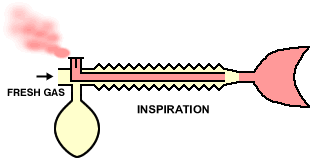 |
|||||||||||||||||||||
|
|
|
Lack Circuit A co-axial modification of the Mapleson A system, designed to facilitate scavenging of expired gas. Construction
A four-way block
is attached to the fresh gas outlet (F). This block is connected
to an outer reservoir tube (R) attached to the patient (P), an inner
exhaust tube (E), a breathing bag (B) and a spring-loaded expiratory
valve (V). Function
The Lack circuit is essentially similar in function to the Magill, except that the expiratory valve is located at the machine-end of the circuit, being connected to the patient adapter by the inner coaxial tube. Inspiration
-The valve closes and the patient inspires fresh gas from the outer
reservoir tube. Controlled ventilation As for the Magill circuit. Operational requirements
Advantages
Disadvantages
Uses
|
Comments on this article
should be addressed to Dr Guy Watney
All pages © Anesthesia Service
and Equipment 1998-2003.


